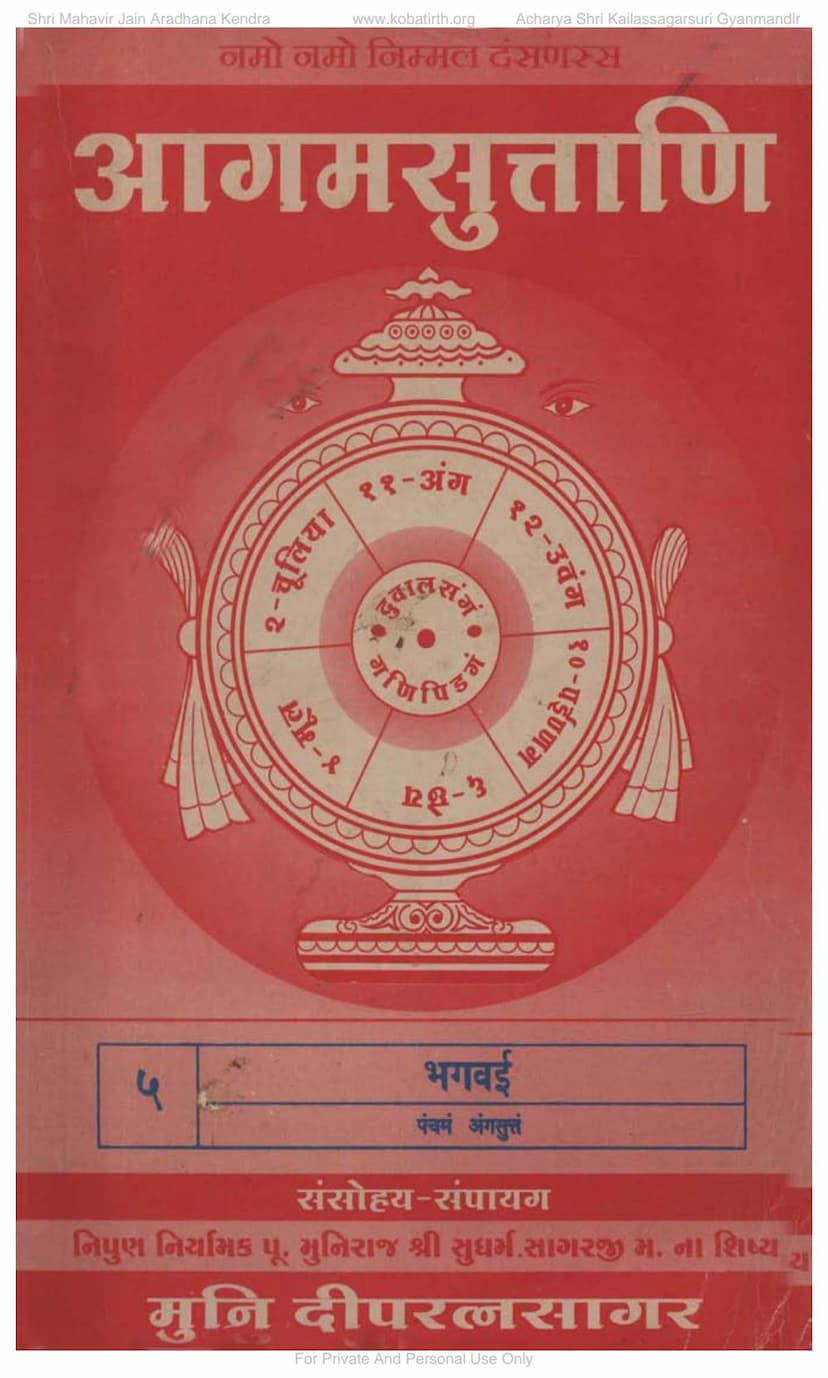Agam 05 Vivahapannatti Angsutt 05 Moolam
Added to library: September 1, 2025

Summary
Here is a comprehensive summary of the provided Jain text, "Agam 05 Vivahapannatti Angsutt 05 Moolam," based on the transcribed pages:
Book Title: Agam 05 Vivahapannatti Angsutt 05 Moolam Author(s): Dipratnasagar, Deepratnasagar Publisher: Agam Shrut Prakashan Catalog Link: https://jainqq.org/explore/009731/1
This document appears to be the fifth Anga Sutra of the Agams, specifically the Vivahapannatti (also known as Bhagavati Sutra), a foundational text in Jainism. The provided pages are from a publication by Agam Shrut Prakashan, dedicated to Shri Mahavir Jain Aradhana Kendra.
Content Overview:
The provided text is the Gujarati rendition of the Vivahapannatti Sutra. It begins with auspicious invocations and dedications, followed by a detailed listing of various donors and supporters who contributed to the publication of the 45 Agam set. This indicates a focus on the dissemination and preservation of Jain scriptures.
The bulk of the transcribed text consists of the Sutra itself, presented in Gujarati with transliteration and possibly commentary. The content is structured into various "Uddesos" (sections or chapters) within "Satam" (Books or Sections). Based on the page numbers and the typical structure of the Bhagavati Sutra, it is highly likely that these pages cover the initial parts of the text, focusing on:
- Introduction and Core Principles: The initial pages likely establish the context, introduce key figures like Lord Mahavir and Indrabhuti Gautam, and perhaps lay down foundational Jain doctrines.
- Discussions on Karma and Souls: There are extensive discussions on the nature of karma, bondage (bandha), fruition (udaya), and the soul's journey through various states of existence (Niraya, Asura, Nagakumara, Tamakumara, Vidhyutakumara, Archiskumara, Svarnakumara, Garudakumara, Vayukumara, Vanaspatikaya, Trividha, Chaturindriya, Panchindriya, Manushya, Deva).
- Cosmology and Geography: The text delves into details about different realms, hellish beings (Niraya), celestial beings (Asura, Nagakumara, Jyotishka, Vaimaanika), their lifespans (sthiti), characteristics, and the structure of the Jain universe, including the various hells (Ratnaprabha, Sharkara-prabha, etc.), mountains (Meru), rivers, and continents (Jambudvipa, etc.).
- Doctrines of Causality and Action: The text explores concepts related to actions (karma), their causes, consequences, and the process of liberation. It discusses how different states of existence are influenced by karma and the importance of right conduct.
- Philosophical Debates and Dialogues: The structure suggests a Q&A format, particularly between Lord Mahavir and his disciple Gautam Swami, where various philosophical points are clarified. This includes discussions on the nature of reality, existence, causality, and the path to spiritual liberation.
- Theories of Perception and Knowledge: There are explanations regarding the senses (Indriyas), the nature of knowledge (Jnana) and perception (Darshana), and the distinctions between them.
- Ethical Conduct and Practices: The text touches upon the importance of adherence to vows (Sanyam, Brahmacharya), virtues, and practices that lead to spiritual purification.
- Cosmic Cycles and Existence: The concept of time (kala) and its relation to the existence of souls and the universe is explored.
Key Themes and Concepts:
- Tattvas (Realities): The text likely elaborates on the Six Tattvas of Jainism: Jiva (soul), Pudgala (matter), Dharma (medium of motion), Adharma (medium of rest), Akash (space), and Kala (time). The discussion of various forms of existence and their interactions points to these fundamental principles.
- Karma Theory: The detailed classification of karmas and their effects on beings is a recurring theme, emphasizing the intricate workings of karma in shaping transmigration.
- Spiritual Path: The text outlines the Jain path to liberation (Moksha) through right faith, knowledge, and conduct (Samyak Darshan, Samyak Jnana, Samyak Charitra). The importance of austerities (Tapas) and renunciation is evident.
- Cosmology: The detailed description of various heavens, hells, and the structure of the universe highlights the extensive cosmological framework of Jainism.
- The Role of Ascetics and Monks: The dedication and effort in publishing this text, often mentioning the inspiration and guidance of monastic figures, underscores the central role of ascetics in preserving and transmitting Jain teachings.
- Rebirth and Transmigration: The cyclical nature of birth, death, and rebirth (Samsara) is a fundamental concept discussed throughout the text, explaining the soul's journey through different life forms.
- The Omniscience of Mahavir Swami: The text, being a discourse involving Lord Mahavir, implicitly showcases his omniscience and the depth of his teachings through the dialogues with his disciples.
The document is a valuable resource for understanding the complex philosophical, ethical, and cosmological aspects of Jainism as presented in one of its most important canonical texts. The detailed enumeration of karmic types, hellish and heavenly realms, and the intricate classifications of beings suggest the profound depth and systematic nature of Jain philosophy.